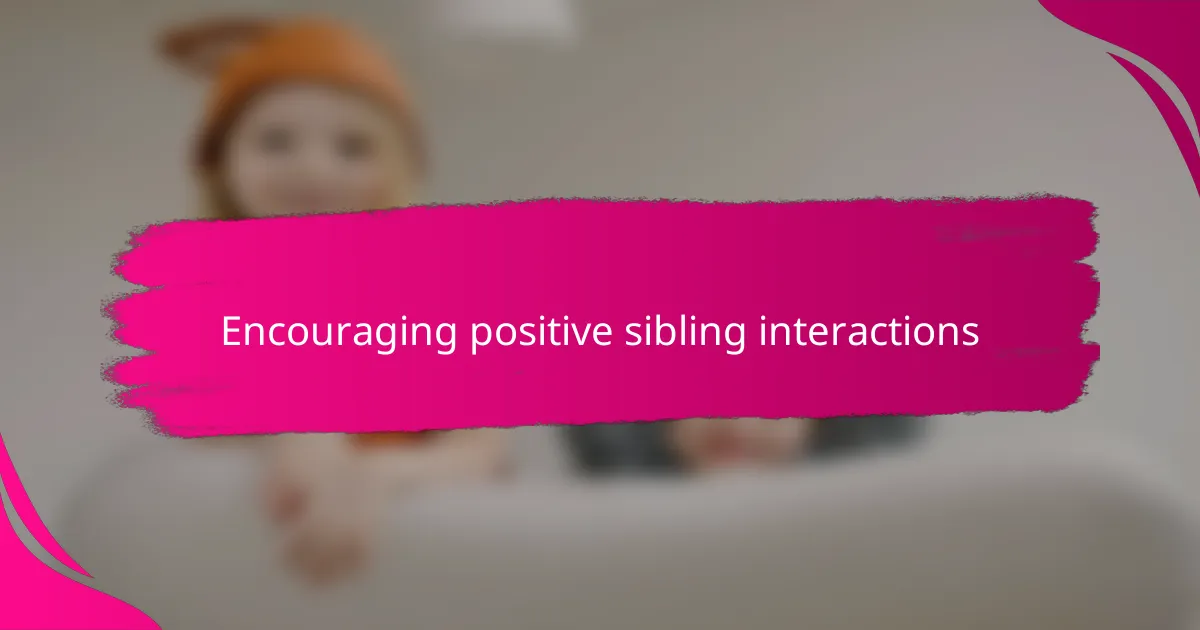Key takeaways
- Sibling rivalry often arises from a child’s need for attention and identity, making empathy important in managing conflicts.
- Effective communication strategies, such as using “I” statements and active listening, can significantly reduce tensions and foster understanding.
- Establishing clear family rules and allowing children to participate in creating them promotes cooperation and a sense of security.
- Encouraging shared activities and acknowledging positive interactions helps strengthen sibling bonds and create positive relationships.

Understanding sibling rivalry
Sibling rivalry often stems from a child’s deep desire for attention and recognition, something I’ve noticed firsthand with my own kids. It’s not just about fighting over toys or space; it’s about each child trying to carve out their unique place in the family. Have you ever caught yourself wondering why a simple disagreement between siblings suddenly feels intense and emotional? That’s because rivalry taps into their need for identity and security.
I’ve seen how siblings may compete not just for parental attention but also for approval and validation. That underlying hunger for acceptance can make small annoyances spiral into bigger conflicts than they might seem to outsiders. It’s fascinating—and sometimes overwhelming—to witness how these feelings play out in daily interactions.
What struck me most is realizing that rivalry isn’t just negative; it’s a natural part of growing up together. Understanding this helped me approach disputes with more empathy, remembering that behind every spat is a child wanting to feel valued and understood. This perspective shift made addressing conflicts a bit more manageable and less exhausting, both for me and my children.

Common causes of sibling rivalry
One of the most common triggers I’ve seen is competition over shared resources—be it toys, space, or even parental attention. It surprises me how something as simple as who gets the last cookie can ignite a fierce rivalry. Have you noticed how quickly fairness becomes a heated debate in your house?
Another cause that really stands out is differences in age and personality. With one child naturally more outgoing and the other more reserved, clashes can easily happen. I’ve found myself wondering if these contrasting traits sometimes unintentionally fuel misunderstandings between siblings.
Looking back, I realize that stress and changes in the family—like a move or a new baby—tend to heighten tensions. When my kids were adjusting to new routines, even small issues felt magnified. It’s like their emotions run on a thinner wire during uncertain times, making rivalry almost inevitable.

Effective communication strategies
One thing that’s made a huge difference for me is encouraging my kids to express their feelings openly without fear of judgment. When I ask questions like, “Can you tell me what’s bothering you right now?” it helps them pause and think before reacting. I’ve seen how simply naming emotions defuses a lot of tension before it explodes.
I also try to model active listening by giving each child my full attention when they speak. It’s amazing how much calmer they feel when they know I’m really hearing them, not just waiting to respond. Have you ever noticed how arguments often dissolve when everyone feels understood?
Sometimes, I guide my children to use “I” statements instead of blaming each other. Instead of “You always take my toys,” I encourage them to say, “I feel upset when my toys aren’t shared.” This small shift in wording changes the conversation from confrontation to connection, making it easier to find solutions together.

Setting clear family rules
Setting clear family rules has been a game-changer in managing sibling rivalry at home. When my kids know exactly what behavior is expected—like no name-calling or respecting each other’s belongings—it creates a sense of security and fairness that reduces a lot of conflicts before they even start. Have you noticed how kids often push boundaries until they understand the limits?
I remember the first time I sat down with my children to create a family “code of conduct” together. Letting them have a say made them feel valued and more willing to follow the rules. It’s not just about laying down the law; it’s about building a shared understanding that everyone benefits from.
Of course, consistency is key. Whenever I see a rule being broken, I calmly remind them of the agreement we made, which helps keep the peace without turning the situation into a power struggle. It’s amazing how clear boundaries can actually encourage cooperation instead of rebellion.

Encouraging positive sibling interactions
Encouraging my kids to spend time together doing something they both enjoy has been surprisingly effective at sparking positive interactions. Whether it’s building a puzzle or cooking cupcakes, shared activities create moments where cooperation feels natural instead of forced. Have you ever noticed how a simple game can turn competitors into teammates, at least for a little while?
I also try to catch and praise acts of kindness or teamwork when they happen naturally. A quick “I saw how you helped your brother just now—that was really thoughtful” goes a long way in reinforcing good behavior. It’s amazing how acknowledging the small wins can build a foundation for more respectful and caring interactions.
Sometimes, though, I remind myself that encouragement doesn’t mean forcing them to get along perfectly all the time. Sibling relationships are a mix of highs and lows, and learning to navigate that is part of their growth. I often ask myself, how can I support their connection rather than demand harmony? This gentle approach has made a noticeable difference in how they relate to each other day by day.

Managing conflicts calmly
When conflicts arise, I try to stay calm because reacting with frustration only seems to fuel the fire. Have you ever noticed how your own tone can either escalate or soothe a tense moment? I’ve learned that taking a deep breath and speaking softly helps my kids mirror that calmness, which often defuses the situation before it gets out of hand.
I also make it a point to step back and observe rather than jumping in immediately. Sometimes, letting them work through their disagreement with gentle guidance teaches valuable problem-solving skills. It’s not easy, but I remind myself that my role isn’t always to fix things instantly but to support them in finding their own resolutions.
One time, during a particularly heated argument over a game, I calmly asked each child to explain their feelings without interruptions. It surprised me how quickly their anger softened once they felt truly heard. Moments like that reinforce how managing conflicts calmly isn’t just about keeping peace—it’s about fostering understanding and respect between siblings.
